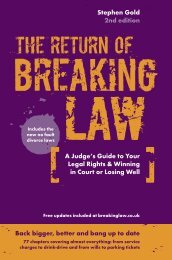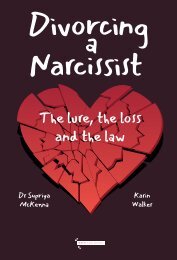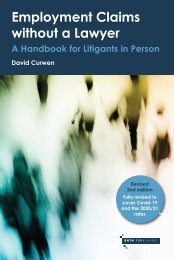Insolvency Made Clear: A Guide for Debtors
Plain English, practical guidance for anyone facing demands over a debt they are struggling to pay.
Plain English, practical guidance for anyone facing demands over a debt they are struggling to pay.
You also want an ePaper? Increase the reach of your titles
YUMPU automatically turns print PDFs into web optimized ePapers that Google loves.
<strong>Insolvency</strong> Law <strong>Made</strong> <strong>Clear</strong> – A <strong>Guide</strong> For <strong>Debtors</strong><br />
Box 7:<br />
VALIDATION ORDERS<br />
In virtue of s284 of the Act, after a bankruptcy petition has been presented<br />
all dispositions of property are void unless they were made<br />
with the consent of the court, either be<strong>for</strong>e or after the disposition.<br />
This does not allow any claim against a third party who received property<br />
<strong>for</strong> its fair price (‘<strong>for</strong> value’) and without notice that the petition<br />
had been presented. However, if a third party does have notice then it<br />
is not safe <strong>for</strong> them to trade with the debtor because the Trustee can<br />
claim against them. The section there<strong>for</strong>e creates a problem <strong>for</strong> the<br />
debtor if they need to sell property or grant a charge over property in<br />
order to raise money to pay their debts.<br />
The solution is to apply to the court <strong>for</strong> permission to make the sale,<br />
known as a ‘validation order’. The debtor should give notice of the<br />
application to the petitioning creditor. A petitioning creditor is likely<br />
to agree to this application, if they think that the transaction is legitimate.<br />
The rules <strong>for</strong> the application are found in paragraph 12.8 of<br />
the PDIP. The court will make the order if it is satisfied that either the<br />
debtor is solvent and able to pay their debts, or that the transaction<br />
will be beneficial to and not prejudice the unsecured creditors of the<br />
debtor as a whole.<br />
The selling of an asset <strong>for</strong> value will not usually prejudice the unsecured<br />
creditors. For example, imagine the debtor owns a car worth<br />
£10,000. Be<strong>for</strong>e the sale, the debtor held an asset, the car. After the<br />
sale, the debtor holds £10,000. The unsecured creditors are no worse<br />
off: if anything, their position has been improved since the debtor is<br />
now able to pay the creditors more easily.<br />
An example application <strong>for</strong> a validation order <strong>for</strong> a company is at<br />
Annex 1.<br />
4. Transactions defrauding creditors: s423 of the Act. This applies even<br />
when the individual has not gone bankrupt, but where they entered into<br />
a transaction at an undervalue and the purpose of the transaction was to<br />
defraud the creditors, i.e. to put assets outside of their reach. Where there<br />
are multiple purposes, the court will apply a ‘substantial purpose’ test, i.e.<br />
that one important result which the debtor intended to achieve by the<br />
transaction was that creditors would be put in a worse position. In general,<br />
Trustees will prefer to use the standard ‘transaction at an undervalue’ approach<br />
where it would not be necessary to demonstrate that the bankrupt<br />
had a particular intention.<br />
24













